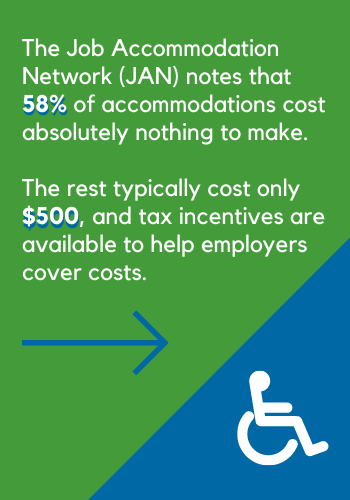Examples of ADA accommodations
 While most organizations with 15 or more workers know they are subject to the terms of Title I of the Americans with Disabilities Act (ADA), confusion sometimes exists regarding accommodation requests. Employers may struggle with how phrases such as “reasonable accommodation” and “undue hardship” apply to the situations they encounter. Fear of botching the accommodation process can even lead to companies shying away from hiring people with disabilities. Not only does such hesitancy deprive qualified individuals of career opportunities, it also subjects the employer to charges of discrimination.
While most organizations with 15 or more workers know they are subject to the terms of Title I of the Americans with Disabilities Act (ADA), confusion sometimes exists regarding accommodation requests. Employers may struggle with how phrases such as “reasonable accommodation” and “undue hardship” apply to the situations they encounter. Fear of botching the accommodation process can even lead to companies shying away from hiring people with disabilities. Not only does such hesitancy deprive qualified individuals of career opportunities, it also subjects the employer to charges of discrimination.
Looking at actual examples of ADA accommodations can ease worries. While exceptions do exist, most reasonable accommodation requests do not prove too costly or difficult to carry out. The Job Accommodation Network (JAN) notes that 58 percent of accommodations cost absolutely nothing to make. The rest typically cost only $500, and tax incentives are available to help employers cover costs.
The following offers a look at some common ADA accommodations. As case-by-case circumstances often come into play, consult legal counsel for specific questions. Employers also may wish to contact the Job Accommodation Network. JAN’s trained staff can help with understanding or modifying accommodation requests to achieve a satisfactory outcome.
Understanding “reasonable accommodation” and “undue hardship”
Prior to examining examples of reasonable accommodations, it can help to have a solid understanding of two key ADA terms. The concepts of reasonable accommodation and undue hardship play important roles in the decision to accept or reject an accommodation request.
According to the U.S. Equal Employment Opportunity Commission (EEOC), a reasonable accommodation is “any change in the work environment (or in the way things are usually done) to help a person with a disability apply for a job, perform the duties of a job, or enjoy the benefits and privileges of employment.”
The goal is for people with disabilities to obtain what they need to do their jobs. Employers are not expected to provide “special” privileges that have nothing to do with accommodating an employee’s disability.
Likewise, the EEOC notes that “an employer never has to reallocate essential functions of the job as a reasonable accommodation, but can do so if it wishes.” Thus, an accommodation request should not involve changing the core functions of a job description. Requesting to switch/eliminate certain marginal tasks or perform them in a different way is within the scope of ADA consideration. An employer is not, however, required to lower quality or production standards to make an accommodation.
An effective accommodation also should not put an undue hardship on an employer. The U.S. Department of Labor defines an undue hardship as “an action requiring significant difficulty or expense when considered in light of factors such as an organization’s size, financial resources, and the nature and structure of its operation.” Covered employers do not have to provide a reasonable accommodation that would cause an undue hardship.
Sometimes, an employer may claim that an accommodation would cause undue hardship because it would place too much burden on co-workers by altering their schedule or expanding their workload. This type of scenario is one that needs close examination on an individual case basis.
What an employer cannot claim as an undue hardship, though, is the potential impact of the accommodation on the morale of other employees. Similarly, an employer cannot reject a request solely on the basis that customers with fears or prejudices toward the individual’s disability will not like the change.
Another thing that an employer should not do is perform a cost-benefit analysis of the proposed accommodation. Determination of an undue hardship depends on the employer’s resources, not on how “important” the person making the request is to the company.
Examples of ADA reasonable accommodation requests
Accessibility
Many people who make accommodation requests have impairments that limit physical mobility. Minor changes to the work environment can have a major impact on their ability to perform. Examples include:
- Reserved parking near the entrance.
- A larger office to accommodate a wheelchair.
- Elevator privileges.
- Changing the location of a cubicle to be nearer to a washroom.
- Modifying the layout of a break room.
- Assigning a wheel-chair using staff member who does site visits to locations that are handicap accessible.
Changes to job tasks
As noted earlier, an employer need not change the essential functions of a job a person was hired to perform. A person with a disability who is unable to perform the essential functions, with or without reasonable accommodation, is not a qualified individual with a disability within the meaning of the ADA. Likewise, the ADA does not require an employer to lower the production standards that it expects of all employees.
However, job restructuring by switching or eliminating marginal tasks typically is within the realm of consideration under the ADA. Examples include:
- Replacing one job duty with another that’s less physically demanding.
- Reassignment to a vacant position with more suitable duties.
- Assigning driving responsibilities to the other member of a two-person team when one person has a vision impairment or takes a medication that prohibits operating a vehicle.
- Eliminating a shift at the front desk for a data clerk with an anxiety disorder because other staff members can easily fill the role and reception area duties are not an essential function of her job description.
Changes to company policy
Employee handbooks lay out rules that a company expects workers to follow. Sometimes, though, these policies conflict with what’s in the best interest of someone with a disability. Employees may ask that an exception be made. Examples include:
- A company with a “no pets” policy allowing service animals.
- An establishment where the entrance greeter stands to welcome guests grants permission for a person with a disability to perform the job sitting down.
- A job applicant with paraplegia is allowed to take an employment test at an alternate site because the customary location has too many stairs.
- A no food or beverages at one’s workstation rule may need adjustment for an insulin-dependent diabetic or someone with a similar medical condition.
Alternate presentation
Companies tend to present information in a standard format. While the majority of people may be fine with the chosen method, employers may need to offer it in a different way to certain individuals. Examples include:
- Training materials written in braille for someone with a vision impairment.
- Providing a sign language interpreter for a worker with a hearing impairment representing the company at an industry conference.
- Assigning an assistant to read notices posted on the bulletin board to employees with visual impairments.
- Making applications for employment available in large print.
- Allowing extra time for a job candidate with a learning disability to complete a skills assessment during the application process.
Modifications to work schedules
A traditional office schedule does not always make life easy for someone with a disability. Requesting alterations in line with their needs can allow people with disabilities to perform at a higher capacity. Examples include:
- Allowing more frequent breaks when symptoms flair.
- Adjusting the start or end time of the day, perhaps to accommodate doctor’s appointments or medical treatments.
- Providing extra set-up or travel time.
- Scheduling breaks at specific times that correspond to medical needs, such as an employee with diabetes regularly breaking to eat properly and monitor blood sugar and insulin levels.
- Granting permission to telework when necessary, such as during inclement weather when travel is difficult or when undergoing chemotherapy or radiation treatment.
- Honoring a request for reassignment to a part-time position.
- Allowing time off for an operation and recuperation (FMLA and worker’s compensation leave may apply too).
 Adaptive equipment
Adaptive equipment
From assistive technology to common items, possibilities abound to help someone with a disability feel better and maximize performance. Note, though, that employers are not responsible for providing personal use items such as glasses, hearing aids, or prosthetic limbs. Examples of possible effective accommodations include:
- Voice software that eliminates the need for someone with arthritis to physically type.
- A stool for a cashier with lupus to use to reduce the fatigue of standing for too long.
- An employee with a hearing impairment using a TTY device (a special electronic machine that transmits conversations as text over telephone lines) to communicate.
- Purchasing a new desk for an employee who cannot fit her wheelchair under the existing one.
- Providing someone who has difficulty writing due to a learning disability with a laptop computer on which to take notes.
- Someone with severe asthma that impacts major life activity requesting that an air filter be set up in her office.
- A worker whose learning disability makes understanding written communication difficult asks for a computer with speech output.
Making decisions about accommodation requests
Remember, types of accommodations vary depending upon the needs of the individual employee or job applicant. Not all people with disabilities will require or want the same accommodation. Even people with the same disability can possess different needs, strategies, and coping mechanisms.
When someone comes forth with an accommodation request, treat it with respect. If your organization decides the suggestion is not a reasonable accommodation or would cause undue hardship, discuss potential alternatives. The employee may even wish to solicit suggestions from her health care provider.
On its website, EEOC.gov, the U.S. Equal Employment Opportunity Commission presents an example of using the interactive process to come up with a reasonable accommodation.
“A cleaning company rotates its staff to different floors on a monthly basis. One crew member has a psychiatric disability. While his mental illness does not affect his ability to perform the various cleaning functions, it does make it difficult to adjust to alterations in his daily routine. The employee has had significant difficulty adjusting to the monthly changes in floor assignments. He asks for a reasonable accommodation and proposes three options: staying on one floor permanently, staying on one floor for two months and then rotating, or allowing a transition period to adjust to a change in floor assignments. These accommodations are reasonable because they appear to be feasible solutions to this employee’s problems dealing with changes to his routine. They also appear to be effective because they would enable him to perform his cleaning duties.”
When both sides keep an open mind and aim for a mutually satisfactory resolution, everyone’s better off. View the interactive process as an opportunity for both the employer and the employee making the accommodation request to get what they want — a worksite designed for success.







